Roubam: a Cycling Odyssey
The 2024 Concours de Machines winner, David Barou, took up frame building after a one-year cycling odyssey in central Asia that changed the course of his career and his life.

“I quit my job, I vacate my shared apartment, I stop my Parisian transport subscription, my Fnac card, my internet box, Netflix, I stop my painting classes, I finish my access book to the climbing gym, and I'm selling some of my furniture. Strangely, freeing myself from everything I have is a relief.”
And so began David Barou’s epic cycle tour across central Asia and the Middle East.
Long bike rides can turn into life-changers, and perhaps this one did just that. Or maybe it just enabled some dormant seeds within him to sprout and flourish, setting the softly-spoken man from the Auvergne-Rhône-Alps onto a new path.
It was a ride that would later inspire the name ‘Roubam’, a linguistic complex that includes wheels and wellness; it is almost anagrammatic of David Barou’s surname; and in Farsi it equates with Anglophones saying, “I’m fine/good/very well, thankyou, etc.”
The bikepacking trip was a story of wanderlust, the yearning of a thoughtful person to follow the path less travelled, experience and survive in lands far beyond the horizon, along the way gaining a greater knowledge of self and the world. It was the action of an adventurous soul breaking free from being slowly stifled in the churning mill of the big city, a soul not ready or willing to accept the stability and comfort of a bland, predictable future neatly laid out in front of him and accessed through the screen of a computer.
 Riding through the remote Pamir Mountains a couple of weeks after leaving the bustle of Paris. Photo: Roubam Cycles
Riding through the remote Pamir Mountains a couple of weeks after leaving the bustle of Paris. Photo: Roubam Cycles
As a youth David pedaled many miles on his mountain bike in the Auvergne-Rhône-Alpes and the Savoie Alpes to the east. As a young adult he already had in him that curiosity about unknown paths, and he’d developed the self-reliance and navigation skills to complete long and difficult routes.
It was not difficult to imagine, then, why he would start this particular trip in the Kyrgyz Ala-Too mountain range, a steep and barren landscape that runs east-west to form a natural border between Kyrgyzstan and Kazakhstan.
This was once in the western protectorate of the former Han Empire, and formed a central section of the Silk Road across Asia created in the Han dynasty. David’s initial plan was a 6,000km trip, which followed that route west before branching to the south where it would end in Dubai.
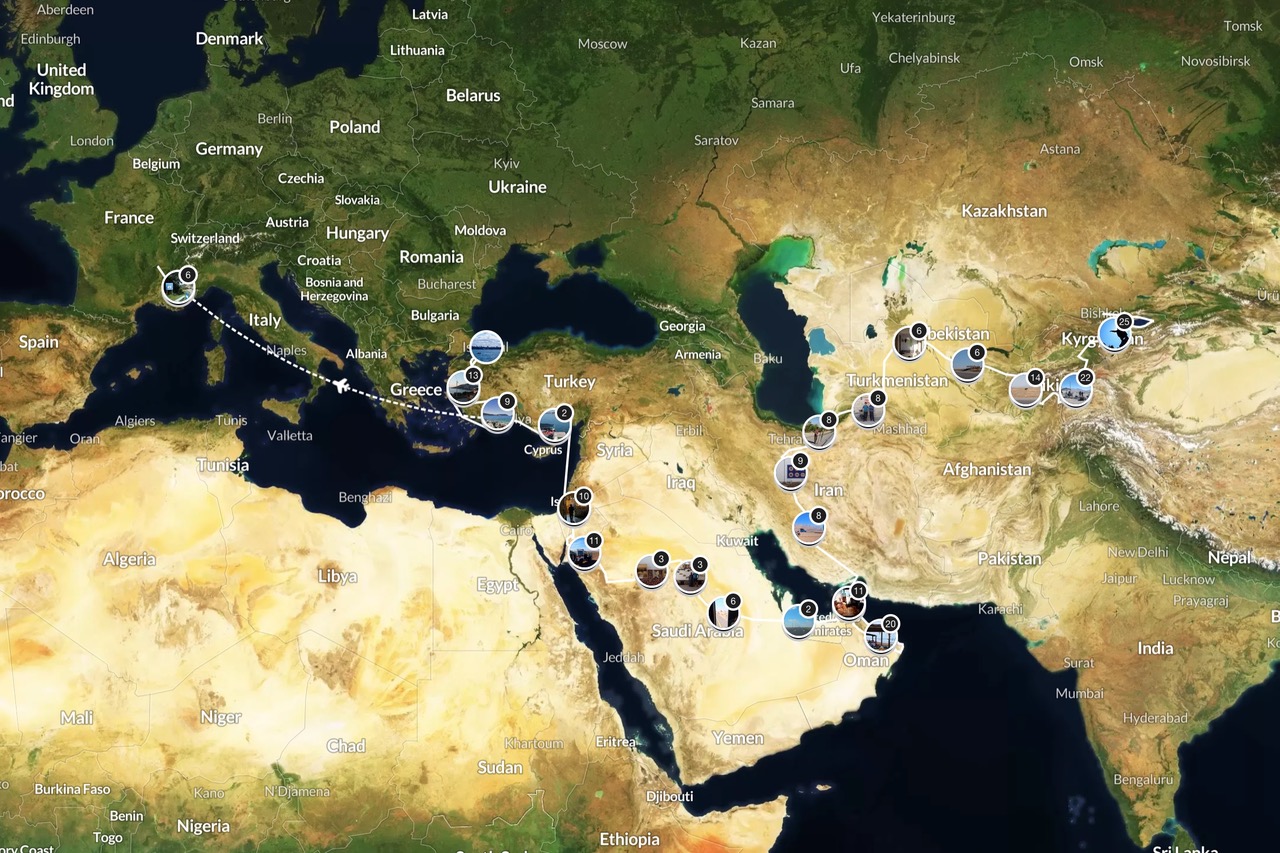 David's epic journey. From polarsteps.com
David's epic journey. From polarsteps.com
Skipping back a few paragraphs, there was that bit about him having a curiosity to know where unknown paths lead to. Well, on reaching Dubai still more roads beckoned, and so on. By the end of it all he’d traveled more than 20,000km in 11 months.
David rode north through the Arabian peninsula into Israel, then air transferred to Turkey, wisely skipping the war-ravaged land of Syria. He landed just as the Covid pandemic was starting to hit hardest in 2020.
The lock-down brought the journey to a premature end. It had already grown into something far beyond its original plan, and given his druthers he’d have kept on riding.
“I planned to end in France, but the route was flexible. My planning was usually based on advice from other cycle tourists about the best roads and routes.” One certainty is that somewhere along his meandering path David realized he would not be returning to his job as an aerospace engineer in Paris with Airbus, where he had worked for almost 10 years since the age of 23.
“I realized I needed to be working with my hands,” he said, but he was not quite ready for Roubam, not just yet.
In 2021 he and two others started making steel staircases. These were designed on a computer, cut with laser equipment, then taken to the customers where they were assembled with rivets. “We tried the most simple design possible. We did not always have access to electricity, so rivets and hammers were the method and tools,” he explains.
All too soon, just as it had disrupted his bike tour, Covid also did a number on his fledgling staircase business. “The price of steel blew up. Our staircases were made of 8mm steel, so our prices were directly impacted. We couldn’t make enough money to support a three-person business.”
Around this time David started to build his first bicycle frame. “It was just a challenge, there was no particular need,” he recalls. Perhaps not a conscious need, but if we consider that mountain biking had been a big part of his youth, and that he had grown up in a family of artisans: both bicycles and manufacturing, and the multiple gateways these two opened up, all this was rooted deep within him.
“I was the only one in my family who went to a big city, then got a job working in an office,” he says. His father had founded a company making elevation systems for lifts, so, with the steel staircases and then bicycle frames, in a sense he was coming home beyond simply rolling in on his bike.
The first frame was old-style: single speed and small tubes.
“At the beginning, I practiced in the barn of my grandparents' house, which I converted to a workshop. My father was a welder, so he gave me advice. I needed a year to make my first bike because I had to build jigs and other tools. Then I decided to learn with other framebuilders.
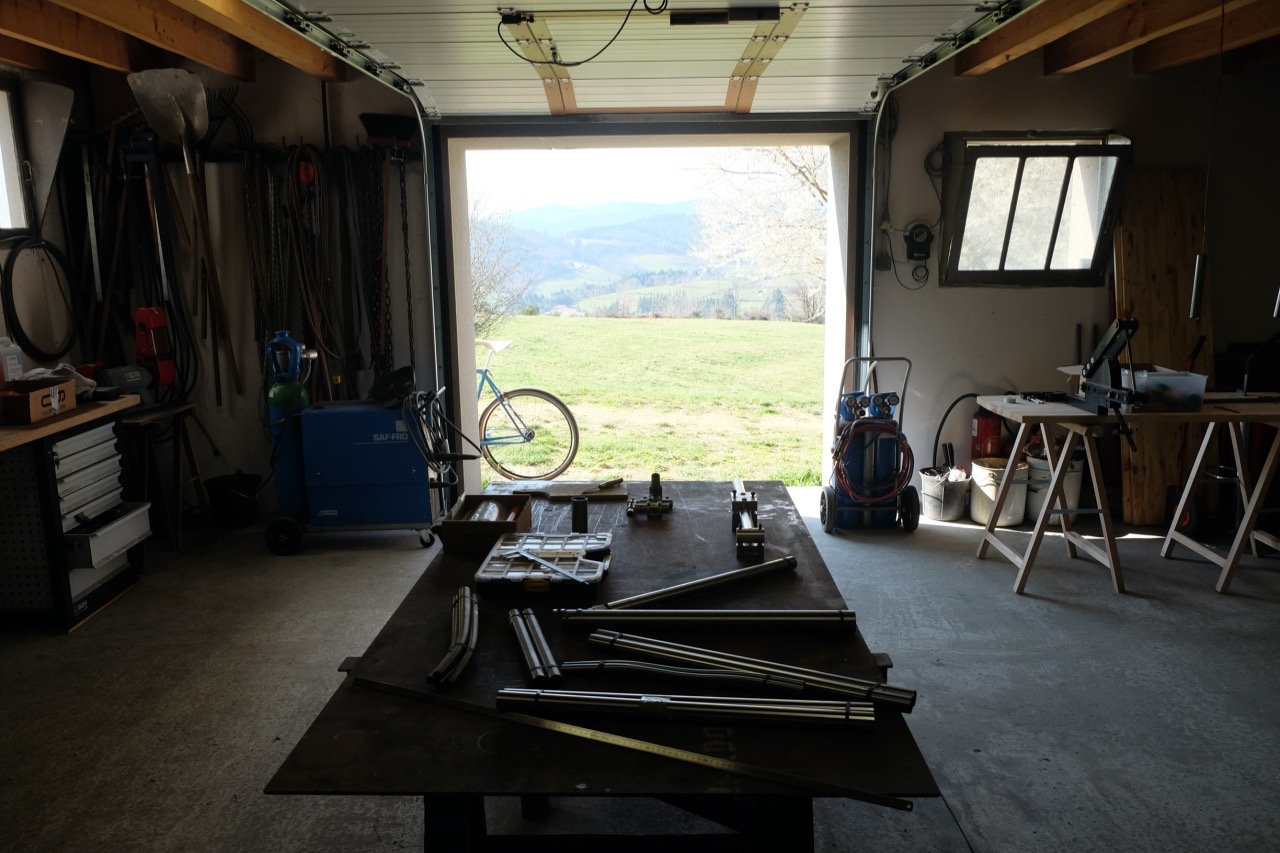 His first workshop. What a view! Photo: Roubam Cycles
His first workshop. What a view! Photo: Roubam Cycles
“Every year I went to a one-week course somewhere in Europe: Edelbike, Grenoble, in 2020; Big Forest Frameworks, Potsdam, in 2021; and Escuela Tecnica Bicicleta, Madrid, in 2022.”
In March of 2022, David founded Roubam Cycles while still working out of the converted barn workshop in Saint-Julien-Molin-Molette.
About an hour away, in Lyon, was the workshop of veteran frame builder Daniel Guédon. After 44 years, Daniel was looking for a suitable successor. “We started to talk and in 2023 I took over his workshop. I kept my brand. He lived next to the workshop, and for about a year he helped, but mostly I did the work myself. His advice was minimal, but it was very specific and useful.”
 The Roubam storefront/workshop in Lyon. Photo: Batiste Nosjean
The Roubam storefront/workshop in Lyon. Photo: Batiste Nosjean
Three years after building his first frame, David decided to enter the Concours de Machines contest.
The 2024 Concours de Machines was David’s first attempt at a bikepacking bike. He sees the bicycle as a highly adaptable machine which can be built to suit a wide range of purposes. “I imagine the bicycle in the image of its rider. Since I adapt bikes to suit everyone, I like to discover new practices and make the bike fit the need.”
 Roubam's Albatros, loaded and ready for adventure. Photo: Batiste Nosjean
Roubam's Albatros, loaded and ready for adventure. Photo: Batiste Nosjean
During the grueling two-day challenge of the Concours, he was pleased to find Albatros performed above his expectations.
The biggest challenge, he said, was not so much covering the tough mountain course, but getting the bike ready for the event. Organizers publish the specifications for the bikes only three months ahead of the event. Building and equipping a competition-special bike from scratch in that time period is a tall order for the vast majority of frame builders.
“You have to remember, most of us are small workshops. For those two months pre-concours we worked nights and weekends. It was very difficult for everybody. We all were very tired at the start. When I was building the bike I thought they should give more time, but now it’s done, I don’t know. With more time I would make something different, and then it would be a different Concours.”
The bike David entered in the Concours de Machines is named Albatros, after the giant wandering bird that travels millions of kilometers in its lifetime. From a distance the bike looks competent, but the intrinsic beauty of a bike is always in the way it performs.

When form follows function: Carefully considered and skillfully excuted design details combine in close quarters to make this bike a beautiful ride. Photo: Batiste Nosjean
“At first, when I started frame building, I tried to make beautiful bikes, but then I realized what makes a bike beautiful is when it is useful, when it works well for the intended purpose. Now my first priority is to make a bike useful, and after that maybe make it beautiful to look at.”
The Machines contest has never been a race in the sense we know them today, but rather a technical trial to test both rider and bike with the intention of advancing bicycle technology. The winner is the bicycle, not the rider.
Before the start, and at the end of each stage, each bike is scrutinzed by the jury. Each deterioration or other mechanical shortcoming is penalized. At the end of the contest, historically the winning bike is the one that presented the best combination of technical innovation and reliability in the field. In recent years other factors, eco-design for example, have come into the reckoning.
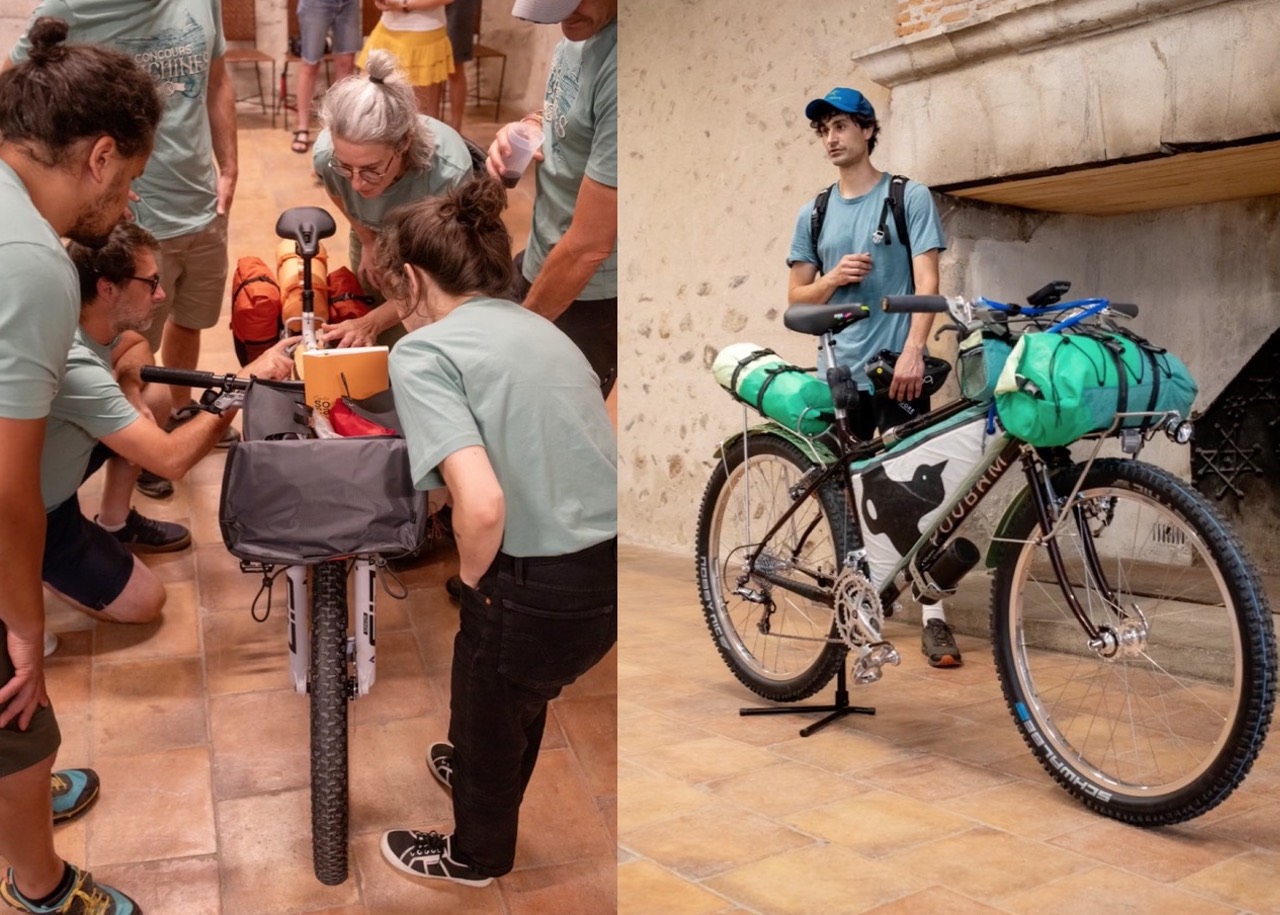 The pre-ride jury inspection, and (r) David describes his bike project to the jury. Photos: Carine Pilosoff @crealens
The pre-ride jury inspection, and (r) David describes his bike project to the jury. Photos: Carine Pilosoff @crealens
For 2024 the criteria included building a bike suited for:
-2 days of autonomous riding on all types of terrain
-170 km and 5200 m of ascent
-Minimum 50 mm (2.0") tyres
Apart from the overall reliability of the bike, the jury focused on:
-Proprietary suspension designs
-Carrying solutions
-Eco-design
-Luggage stability
-Tools integrated into the bike
-Lightweight mudguards
-Dimensions adapted to train transport
 The rack and fender mounts, the biplane fork crown, the XTR V-brake(!)... This pic could be worth more than a thousand words! Photo: Batiste Nosjean
The rack and fender mounts, the biplane fork crown, the XTR V-brake(!)... This pic could be worth more than a thousand words! Photo: Batiste Nosjean
We already know that a ferrous steel frame is one of the most energy-efficient materials in bicycle frame construction, surpassed only by wood and bamboo. David chose a Columbus steel tubeset, which comes from Milan, about five hours by car from his workshop in Lyon, another factor in the jurors’ reckoning.
Focused on the ‘Eco-design’ stipulation, he purchased as few new parts as he could. Some of the components came on the market more than 20 years ago. “My idea was to make a bike with used parts. I had three months to gather everything. These parts had been sitting in my shop, or somebody’s garage, for several years. Everything except the spokes, saddle and hubs were second-hand. ”
Old parts:
- Shimano XTR M960 9v rear derailleur, year 2002.
- Shimano XTR M901 3v front derailleur, 2000s.
- Shimano XTR M960 V-brake calipers, 2000s.
- Shimano XTR M739 brake levers, 2000s.
- Campagnolo crankset, 90s.
- Bernard 2.0/1.8mm spokes, ancestor of Mach1, before 1997.
- MBK Gel Turbo saddle, 90s.
- Shimano XTR 9v cassette and chain, 2000s.
- Suzue Classic Road front and rear hubs, contemporary parts.
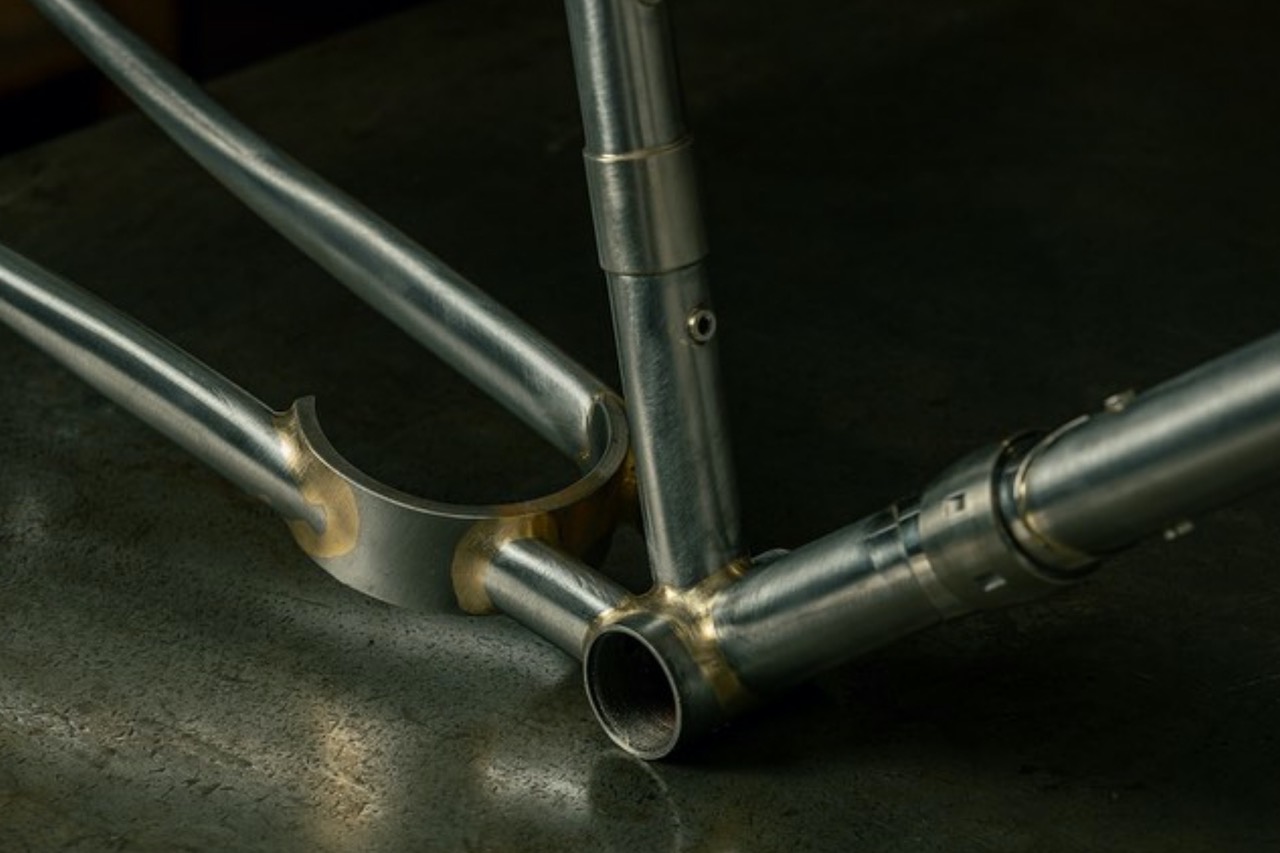 In our experience, asymmetric rear ends when done right are excellent. Photo: Batiste Nosjean
In our experience, asymmetric rear ends when done right are excellent. Photo: Batiste Nosjean
He explains:
“The Suzue rear hub is a road hub for a 130mm axle. Since the machine is intended for mountain biking, we centered the rim on the flanges to balance the tension of the spokes. Result: the rim is offset by 6mm from the center of the hub.
“With a proprietary yoke, I created an asymmetric rear triangle that accommodates a 2.4 x 27.5” tire, a triple 24/33/46 tooth chainring, a 68mm bottom bracket, and the offset wheel.”
S&S Tube couplers and cable couplers enable the bike to break apart quickly and easily to meet the SNCF (French national railway) baggage specifications.
David included a few handmade parts on the Albatros:
- Homemade stem, handlebars, rack, and frame.
- Saddlebags created from a dinghy sail by @poppinsbikepacking
- Mudguards 3D printed by BA3D.
- The paint finish: @hervecally
- Wheel racking: @jul_jurassic
And finally, some new parts:
- The Star bar seat post (France)
- The chainrings: @specialites_ta (France)
- The bottom bracket: @specialites_ta (France)
- Front and rear lighting: @sonnabendynamo (Germany)
- The rim dynamo: @velogical_velospeeder (Germany)
- Friction levers: @rivbike (USA)
- Voyageur 650b rims: @velo_orange (USA)
The frame is made of Columbus steel tubes: @columbus_official
The 2024 route for the Concours de Machines took the event to the Pyrenees, the venue of an early bicycle technical trial, in 1902 or ‘03 depending on who you read. The 2024 route covered 180 km and +5000m of elevation on a route that included a punishing hike-a-bike and descent of the rocky path to Pic du Midi de Bigorre, high above the famous Col du Tourmalet.
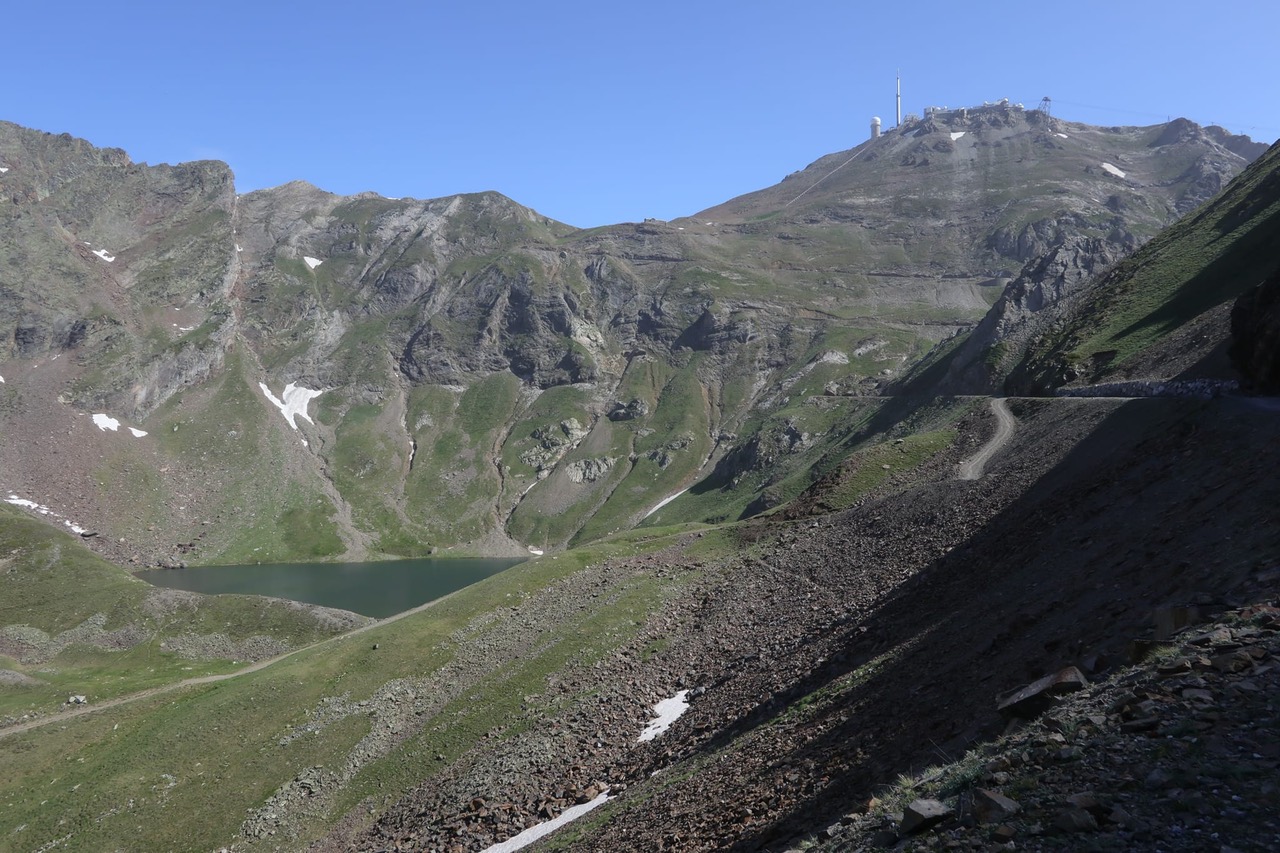 They had to climb all the way to the top, the Pic du Midi Bigorre observatory. Photo: Cycles Itinerances
They had to climb all the way to the top, the Pic du Midi Bigorre observatory. Photo: Cycles Itinerances
David was confident in his bike, but apprehensive about his own ability to cover so many steep uphill kilometers in such a short period of time.
He needn’t have worried. Following his year-long cycle tour in 2019/20, in 2022-3 he completed three ultra-cycling races in Spain, Italy and Morocco. Miles such as those don’t quickly leave the legs.
“The first day was very difficult because of the sun,” he recalls. “We all had a very bad time. There was no shade, it was very dry, hot, and sunny. We were climbing, so there was no wind to cool us.”
He reports that the atmosphere among the contestants was friendly and supportive, much like in a Brevet. “We rode more or less together, helping each other with motivation when things got difficult.”
 David on a steep gravelly incline to the Pic, and (r) higher up it got too gnarly to ride. Photos: Carine Pilosoff @crealens
David on a steep gravelly incline to the Pic, and (r) higher up it got too gnarly to ride. Photos: Carine Pilosoff @crealens
The group of 17 contestants were joined by well-wishers along for the ride or part of it. At times, David recalls the group numbered more than 30 riders.
“The goal was just to finish the tour. Most of us felt the same way about this.”
After a punishing day in the saddle, the group arrived at their campsite high above the hamlet of Barèges, the site of therapeutic baths once used for Napoleon’s armies. Much as their tired limbs might have welcomed those mineral baths, they were happy with their lot. “We had a very nice bivouac, it was close to a small river… beautiful. We all carried (and slept in) tents, because of the weather. Sometimes it was raining—it’s the mountains so the weather is unpredictable—and it got quite cold at night.”
The second day started with the arduous ascent to the Pic du Midi de Bigorre, which was followed by a 26-mile descent before a very lumpy 25 miles to the finish at the abbey in Bonnemazon, where soon after arriving David was informed his bike, Albatros had won the 2024 Concours de Machines.
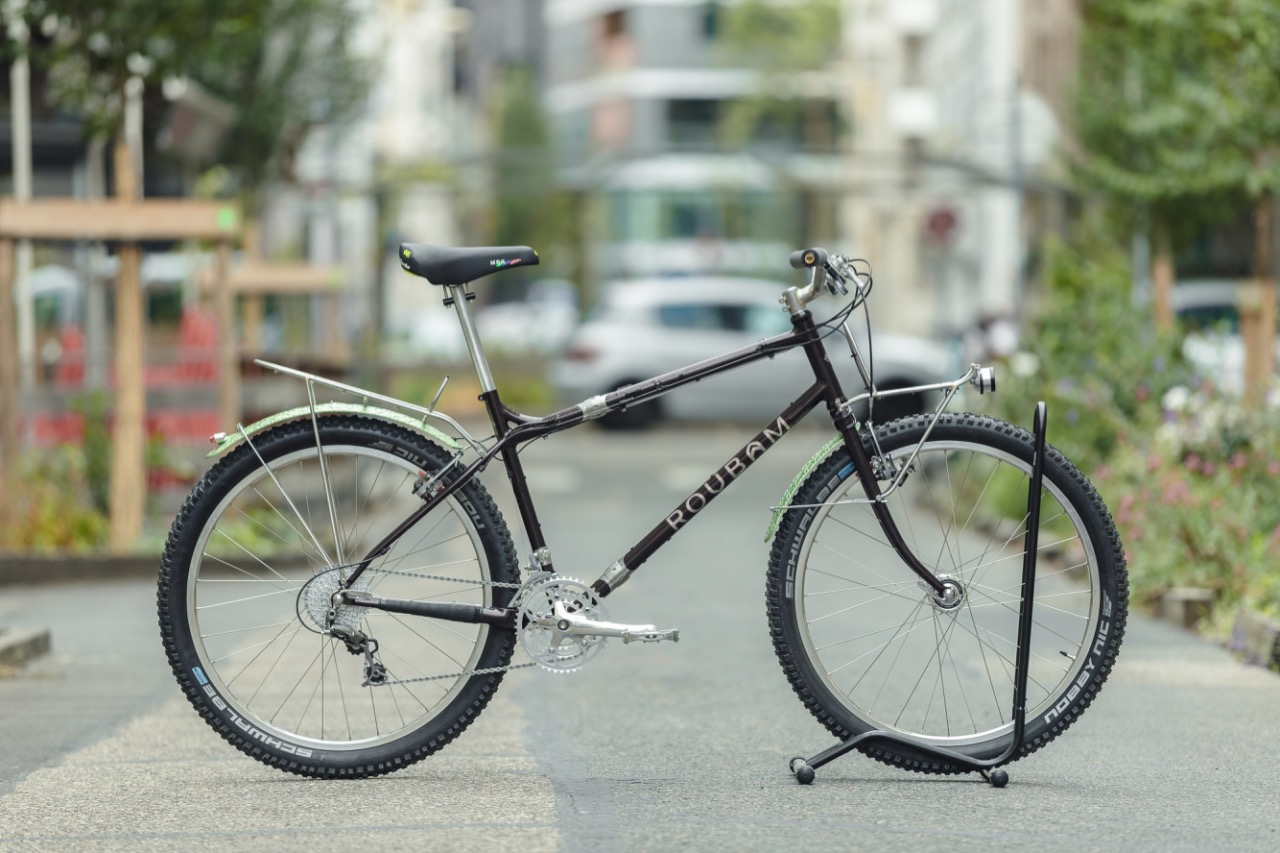 Albatros, unladen. Photo: Batiste Nosjean
Albatros, unladen. Photo: Batiste Nosjean
After all the dust had settled, back in his workshop some days after the event, he said, “Maybe I will do it again, I don’t know when.”
It takes a well-developed spirit of adventure to participate in the Concours de Machines. Maybe David will, or maybe he won’t take up that particular challenge, but one senses the remainder of this story takes place not only in a bicycle workshop in Lyon, but in venues farther afield too.
At HBG we’re very interested to see where David's sense of adventure leads his capacity for invention, not only in bikes he makes for himself, but also those for his customers.
Thanks to the many individuals and organziations that helped make this article possible:
Roubam Cycles
Batiste Nosjean
Carine Pilosff @crealens
Association des Artisans du Cycle
Cycles Itinerances
Polarsteps.com



